A cat-friendly home – yes, there is such a thing – or is that a contradiction in itself?
Our house cats are part of the feline family. Its larger relatives are cheetahs, lions and tigers – predators, and pretty wild at that!
Those who observe cats in the wild will notice this relationship straight away.Roaming through meadows and woods, embarking on unknown paths and discovering secrets – this is the intrinsic nature of cats; when the sun peeks through the trees, with something crackling here, something scurrying over there and the hunting grounds unfolding enticingly ahead. What cat could resist?
Some cat owners who keep their cat in a city apartment may have a guilty conscience or sometimes wonder whether their cat’s life surrounded by walls is actually worth living. But don’t worry:
It can be!
– if you create the conditions that allow the cat to live in a way that fits with its wild nature.
How large does a home need to be for a cat to live in it?
Your cat needs movement. As a hunter, its body is designed for stalking, jumping and climbing, as well as for quick sprints. Making a standing jump, landing accurately and running at gallop pace with a top speed of 50 kilometres per hour – not a problem for cats! And all that with incredible sleekness!
It may look so casual but it is actually the work of its musculoskeletal system, with joints and muscles perfectly synchronising over the course of evolution. The home should offer plenty of space for the cat to move around in – a “shoebox apartment with a kitchenette” is definitely out of the question!
How many square metres per cat?
It can be endlessly disputed whether 40, 50 or 60 m² are enough; attention should not only be paid to the “right” amount of square metres, but rather to how the life of the cat is organised – this specifically concerns the division and layout of the space. A territory that your cat can survey at a glance is certainly less appealing than several rooms that can be rediscovered time and time again. Even outside, territories become smaller the better the food is – But even cats with full stomachs want to hunt!
Psychological elementsplay an important role: imagine how spending every day in the same space, which can be quickly paced out, would be for you – you would be bound to get bored. At some point, your concentration drops – there is nothing for you to focus on – and you become sluggish and depressed. The only highlight is feeding time! You live for it and eventually become overweight. A grim picture, admittedly, but it is very easy to create attractive stimuli with a bit of creativity and sensitivity.
Increasing the usable space with things to climb
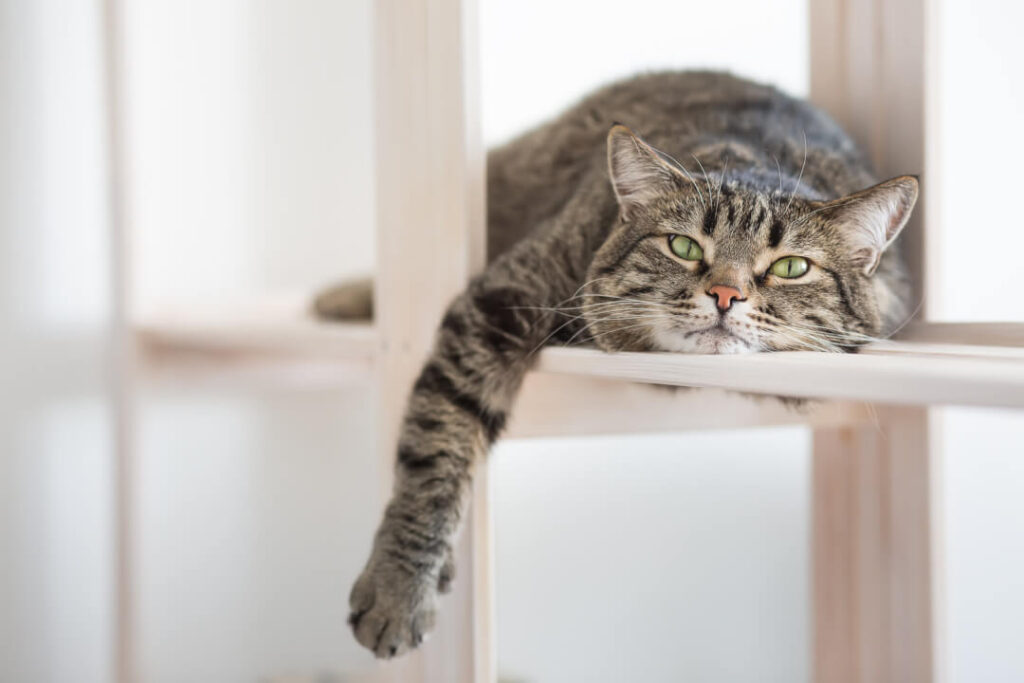
Even the smallest of houses have space for climbing adventures! With a bit of imagination and an eye for interior design, you can increase the living space of your cat by creating areas for climbing, running and resting on the walls.
And the window seat is reserved for velvet paws! On an exclusive basis and with a season ticket. Cats love to sit on the windowsill! Firstly, it is an elevated lookout where the cat can see all of its territory, and secondly, there is always movement and action outside – this attracts the eye of the hunter.
They can also bask in the sun, and in winter heating provides cosy warmth from below: a veritable cat heaven with a view. It is therefore no wonder that window seats are so fought-over! Some cats are not so keen on sharing it with other cats or potted plants.
Bring nature into your home
Outdoor cats get to experience a variety of different sensations on a daily basis: tastes, smells and sounds. House cats need to be content with a much smaller living space that is dominated by humans. But this can certainly be made more exciting.
1.
Decorate your home with natural materials: stones, clay, wood or plants such as seaweed and moss.
2.
Indoor fountains are very popular among cats – preferably with balls that move in a water jet or waterfall. Pet stores also sell special drinking fountains especially designed for cats.
3.
Plants for cats: create a green oasis for you and your cat. You can put plants in buckets or pots to make it more interesting. Grasses such as bamboo or sedges are preferable. Blue fescue and beachgrass are also suitable.
4.
Even cats that have never been outdoors love the sounds of nature, probably stored in their subconscious. There are CDs with natural sounds that you can play. However, please make sure to keep the volume low as most cats do not like sounds that are too intrusive or loud.
Cat grass
Cat grass is not only for decoration, it also has an important function for cats: when cats clean themselves, they swallow hair. How does this happen?
Cat tongues are rough and they work like a brush with bristles and many small barbs: when the cat cleans itself, the hooks line up, combing the coat and capturing loose hairs that are then swallowed. The swallowed hairs normally collect in the stomach and are subsequently excreted via the intestinal tract. When too much hair is collected, the cat eats grass in the wild – mainly the coarse – grained part of the plants – so that they can vomit the indigestible hair. Admittedly, it is not so appealing, but it is a completely natural process for your cat.
You should therefore offer cat grass to house cats as a replacement. Cat grass is available in pet stores in different varieties and can easily be brought into the home.

Barley grass is well accepted by most cats. Like all grain grass types, it tolerates no midday sun and needs little watering.
Barley grass is very soft.

Oat grass is another safe grain grass for cats. The blades are very soft.
The earth should be damp but never too wet.

Just like all grain types, wheat grass is a sweet grass. As opposed to the traditional use, the wheat shoots are harvested after 3 weeks for the grass variation. Wheat grass is very soft and needs little watering. Midday sun is to be avoided but a humid environment is welcome.
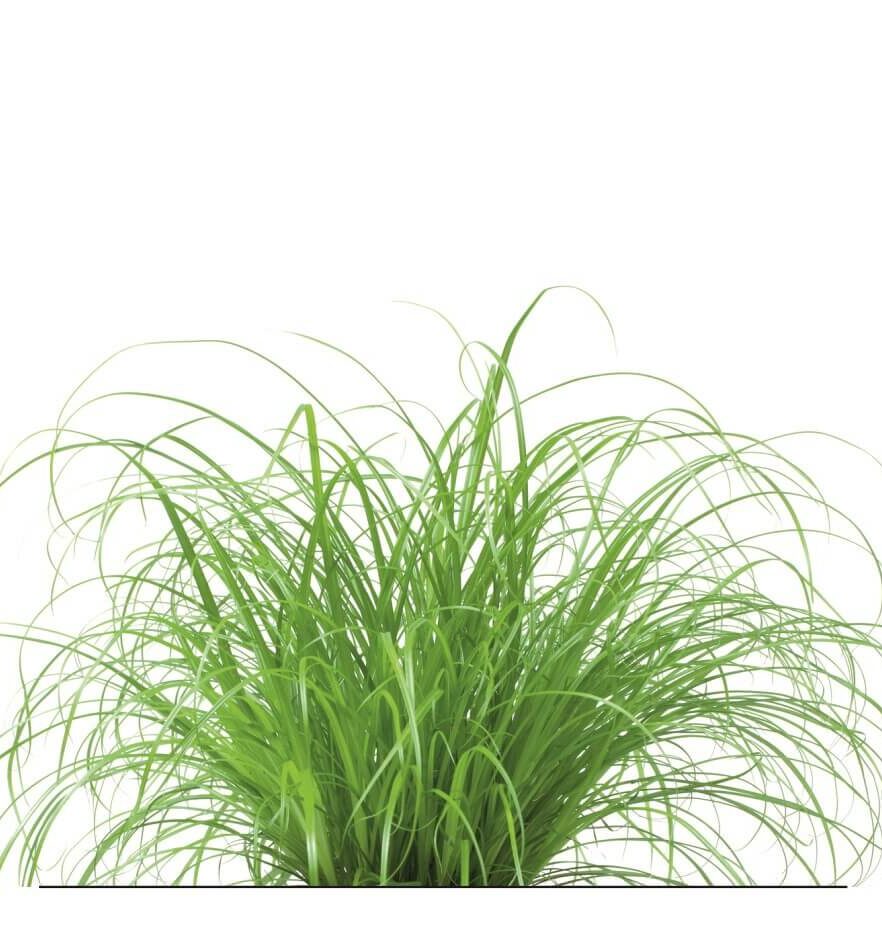
Papyrus (Cyperus papyrus) is an all-time favourite for many cats. However, the blades are sharp-edged – this can lead to injuries and the usage needs to be well-supervised! A safer choice is the miniature version (Cyperus Zumula), which is a little softer. Papyrus appreciates a light filled, warm and moist environment.
Introduce natural objects
If your cat doesn’t go outside, simply bring the outdoors to your cat! On your next walk, think of your little tiger back at home and bring it something exciting and freshly picked from your trip! What exactly? You can choose!
Wherever you go – be it in summer or winter – you will find something exciting that you can pick up without much fuss, even something you can fit in your pockets! Depending on the season, this could include beechnuts, pine cones and acorns or perhaps ears of wheat or twigs with leaves or flowers.
Let your cat have a social life
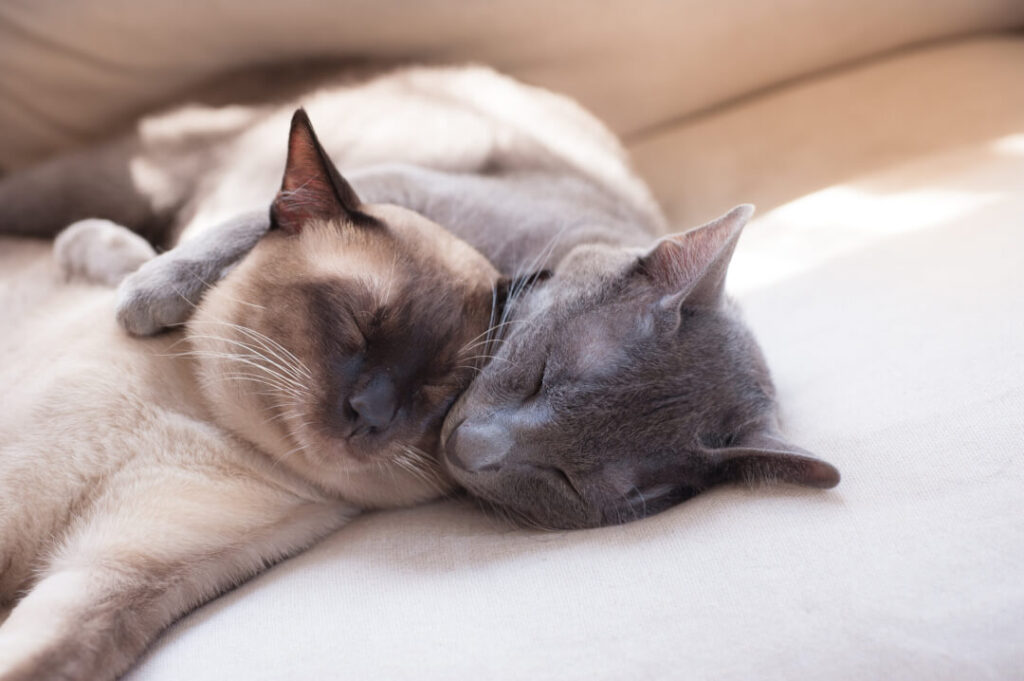
Before you do, remember that not all cats are the same. They vary widely. “Cats do such and such” and standard instructions for cats derived therefrom do not exist! Those who take the trouble and closely observe the behaviour of larger and smaller cats will notice that there are both similarities as well as big differences among cat families. For example, lions hunt in packs, but our domestic cats prefer to do so alone. This probably has something to do with habitat and evolution.
Domestic cats are rather individualist, but definitely need more social contact – to a greater or lesser extent, depending on their character. As kittens usually spend the first phase of life with their mother and siblings, they also learn the cat code of conduct during this period.
During these first months of life, social behaviour is “programmed”; everything that a kitten becomes acquainted with during this time develops into their behavioural patterns over the next years of life. For example, whether or not they like other cats – overall or only those of its variety – and want to make friends. Cuddling, playing, scuffling and grooming when they are in the mood makes for great fun and no humans can quite do it like another cat can!
Why to not keep cats alone
Cats are is stimulated and has a zest for life… House cats therefore need playtime and plenty to keep them occupied on a daily basis. If a cat is kept on its own and has no companion to tussle with, it may be the case that your appendages or furniture need to be sacrificed. Offer your cat appealing scratching areas – preferably as many as possible, but at least 1 to 2 per living space.
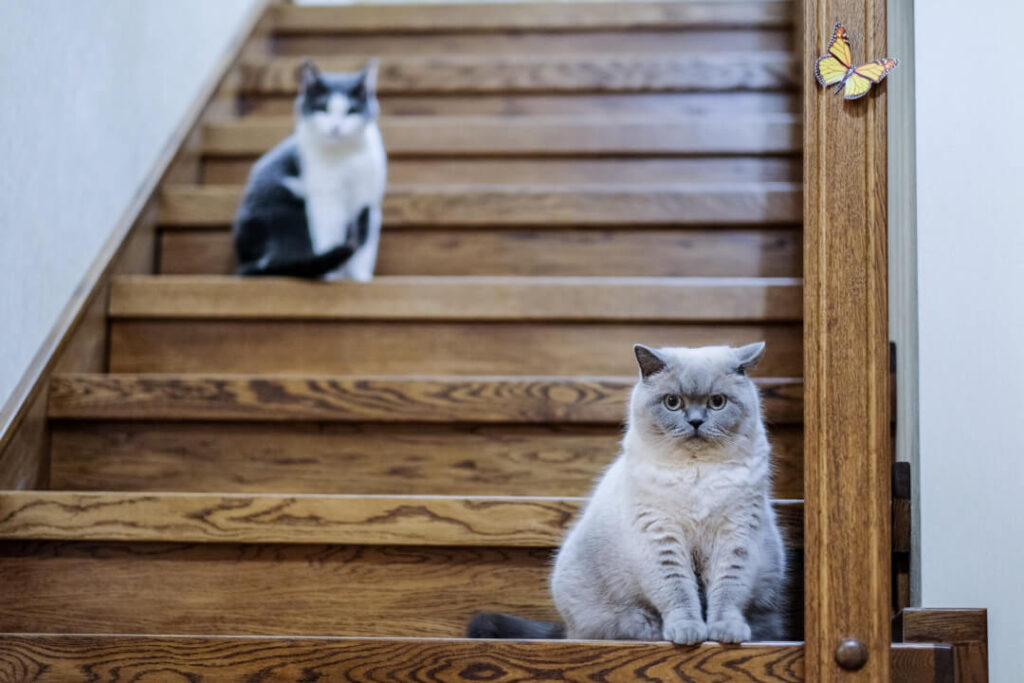
Now imagine that as a cat you might not necessarily like all your fellow cats , but you have to live completely alone on a desert island where you have every comfort imaginable but no one to talk to, cuddle or argue with. As cats generally do not have smartphones and desert islands do not have network coverage, you would be completely isolated from the outside world!
OK, living as a hermit can certainly feel liberating, but many cats develop behavioural disorders if they are left alone: some become mentally ill and withdraw completely, while others become nervous or aggressive.
So never keep just one cat in your home – it is better to have two or three.
But how can you tell if cats can actually take each other?
Brushing and combing
Scientists have dino danger.
But once windows are tilted open or a breeze slams the door shut, it can get risky: cats are hunters –indeed a buzzword here – and it is extremely important to understand the nature of cats as curious creatures. Don’t be misled by their thick coat! Cats can squeeze through anything – where the head passes through, the rest follows.
A cat that tries to pass through a window that is tilted open can easily get caught and become seriously injured. Doors can also lead to problems: a cat is passing through and suddenly the wind or a careless person slams the door shut! And just like that, the cat’s tail is caught in the door.
It is really easy to secure doors and windows. For windows, there are – depending on taste and structural circumstances – nets or roller blinds for the side angles or openings to prevent the cat from passing through.
The owners of cats who disappear at the first sight of a comb can only smile at this with tired eyes. But it actually makes sense to get cats used to the brush and comb and form a kind of positive ritual out of it, which can also help strengthen your relationship with your cat.
Considerations for areas of retreat
“Kitty… kitty?!” – but no furry friend to be found? Cats often seek out the most curious hiding places, squeezing themselves into the narrowest nooks and crannies – nothing is out of the question!
Retreating is a completely natural part of cat behaviour. There is no single reason why cats do this, rather several: when looking to rest, they retreat to a safe place – preferably with a view of their area (while resting, a need to spring into action may arise – perhaps prey or fun, or even both!). Cats also retreat when things get unpleasant and danger appears: as is widely known, retreating is the best defence! They will first scout ok doors with door stops – some even with cat-shaped designs, if you prefer.
Considerations for cat fun
Want to offer your house cat more variety? Excellent!
You don’t need to spend an enormous amount on cat toys to achieve this! With just a sprinkle of imagination you can make many things yourself – and with simple things that can be found in almost every home! To do this, just put yourself in the place of your cat: you are a hunter. What do you like doing the most?
Exactly! Lurking, hunting and, of course, capturing prey! Create stimuli that satisfy their needs. This might sound challenging, so we’ve devised the next section to provide some help.
Cat toys
Awaken the hunter in your cat!
Keep in mind, however, that not all hunters are the same. Some like quick, rousing games, others like to spy on their prey and then there are those that prefer to just hunt in their head – brain games that involve strategy. It doesn’t always need to be prey – you can also reward them with food or a treat. Most games work very well with “substitute prey”.
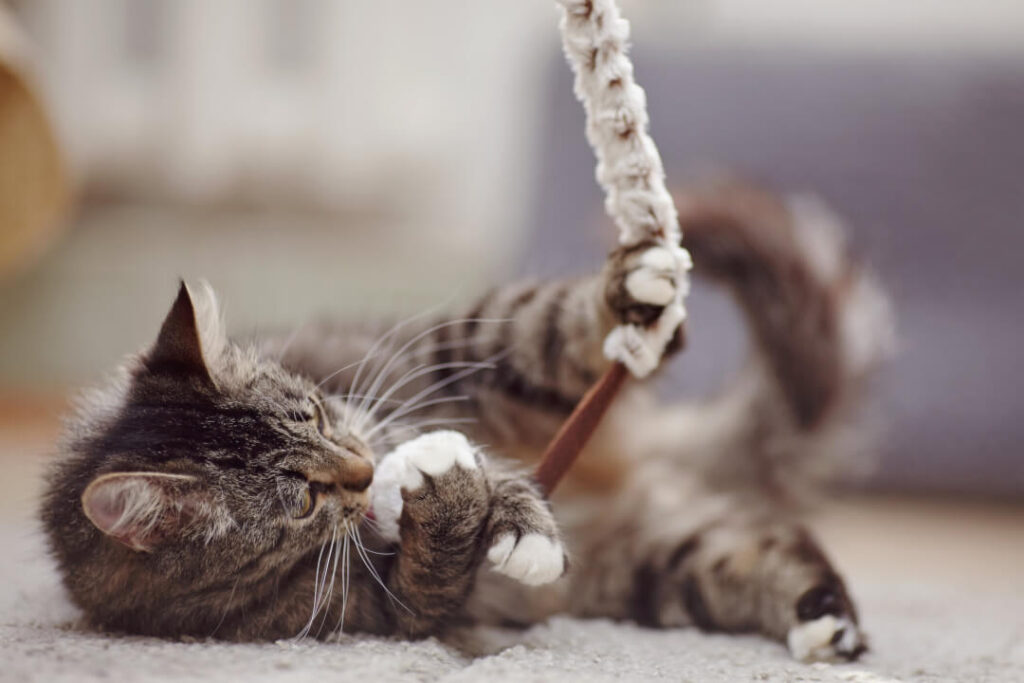
Here are a few suggestions:
1. Fishing:
fill a bowl with water and place a ping-pong ball or cork on the surface – the larger the surface, the more exciting the game!
2. Searching:
give them cartons, boxes or large paper bags with holes. Put something inside for them to discover (bits of paper, toys, leaves, pine cones or the like).
3. Spinning:
spinning tops made of wood are available in many toy shops at a low price; you can propel them with a string or by hand. Cats love chasing them or pushing them with a little prod of the paw.
4. Poaching:
other flatmates might also have a great toy that the cat can borrow, such as a dog toy.
5. Squash:
throw balls against the wall and let the cat catch them.
6. Lurking:
let the “prey” poke out of a hole and disappear again. At some point you’ll need to offer up the prey, otherwise even the most patient hunter will lose interest.
7. Catching:
use a firm leather strap with or without attachments and quickly pull it across the floor. It is the absolute classic – easy to adjust and indestructible. Also try throwing small balls, toy mice, crumpled up paper or (shelled) walnuts.
8. Light play:
let the cat chase the torch light in the dark. Start the game close in front of the cat to give it a real chance to “catch” the light.
Important: please do not use laser pointers as they can cause serious retinal damage if shone in the cat’s eyes!
Entertainment for cats
1. The digital world can open up unexpected opportunities for cats! Whether a video game or app for cats, even house cats will get their fill – provided you are open to it. In this case, this is something you should only use every now and again rather than as constant entertainment. Staring at the tablet or screen on end is tiring and not really suited to cats (or humans!).
2. The retail market also offers an abundance of automated toys for cats that – once nudged –run, roll or jump on their own. This will certainly be fun for your cat for a while, but at some point it gets boring. Just imagine how predictable it would be for an ambitious hunter to already know beforehand what the “prey” will do next. The only exciting part here is the movement – but this only goes so far. For this kind of activity, you might get the occasional prodding of a paw at some point, but that’s it.
3. Brain games that continuously stimulate the intelligence of the cats are much more interesting. “At what point should I give it a treat?” You can keep coming up with a new task; however, your cat should at some point feel a sense of achievement. Setting the bar too high can be frustrating for your cat. Make sure that they also have a sense of achievement and receive a little treat for special tasks. This helps to motivate them!
DIY: Intelligence Games for your cat
With all the entertainment on offer outside, please don’t forget that your cat is an animal and should stay that way.
This means that no toy, no matter how sophisticated, is a suitable replacement for your company or that of other cats. Simply try to spend as much time as possible with your kitty! You don’t constantly need to organise special events – just be yourself. Let the cat take part in your life and show it that you appreciate it. Stroke its head when it lingers near you, but let it take a nap in peace and accept its areas of retreat.
Pamper your cat. Just like for us humans, affection is vital. Touch, closeness and body contact – your cat needs all these things, but in moderation please! Remember: your kitty will decide when it has been cuddled enough. Do not force your cat to do anything that they don’t really want to do.
- Stroking areas: back, sides, chest, behind the ears, chin, between the shoulder blades
- Do not stroke against the fur!
If you observe your cat’s body language while pampering it, you will find out over time what they love and what should be left out – it is better to leave out the no-go areas…
Treat your cat to a little bit of pampering in the form of a massage (but leave out the oil as it won’t go down well!):
- With gentle pressure, start at the head and work your way down to the tail.
- Start with your fingertips behind its ears, massage the flanks and shoulders.
- Spread out across the back to mark the end of the massage.
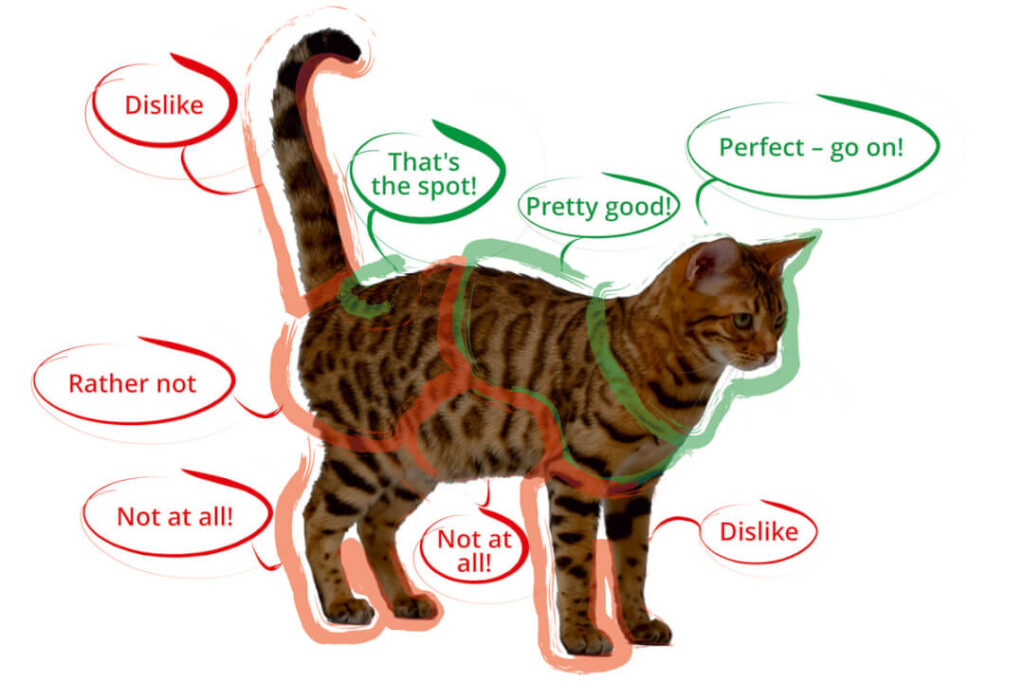
Note: you can also massage above the eyes with small circular movements, many cats find this particularly enjoyable!
Scratching furniture for cats
Catching prey, fighting and escaping – the joy of movement is not only what keeps the body fit, but also ensures that the cat is stimulated and has a zest for life. House cats therefore need playtime and plenty to keep them occupied on a daily basis. If a cat is kept on its own and has no companion to tussle with, it may be the case that your appendages or furniture need to be sacrificed.
Offer your cat appealing scratching areas – preferably as many as possible, but at least 1 to 2 per living space.
Cat scratching post:
it is best to choose a cat scratching post made out of natural materials, for example, non-toxic wood. Not only is the high-quality workmanship impressive, as they are free of chemicals, they are also good for the cat. They are admittedly more expensive to buy but in the long run it is worth investing in a sturdy post.
Scratching barrel:
there are cat scratching barrels with entrances to crawl into and padded areas inside for lying down on. The cat flap allows you to kill two birds with one stone: the robust structural fabric is perfect for clawing and the caves offer cosy retreat areas: a new favourite spot for your house cat!
Designer scratching furniture:
those wishing to add a special touch to their home can also add to their interior design with unique cat furniture. Not only does this upgrade the space, it is also fun for the cat and spectator!
Consider the hazards in your home
“Most accidents occur in the household” – a truth that unfortunately also applies to house cats if the home has not been made “cat safe”.
Many cat owners say that cats that are kept exclusively in the home are well taken care of. Sure, and they are – especially given the fact that there is (normally) no confrontations, environmental toxins or road traffic; yet even a “civilised” household also harbours a number of risks you should be aware of.
Windows and doors
As long as windows and doors are closed, there is no danger. But once windows are tilted open or a breeze slams the door shut, it can get risky: cats are hunters –indeed a buzzword here – and it is extremely important to understand the nature of cats as curious creatures. Don’t be misled by their thick coat! Cats can squeeze through anything where the head passes through, the rest follows.
A cat that tries to pass through a window that is tilted open can easily get caught and become seriously injured. Doors can also lead to problems: a cat is passing through and suddenly the wind or a careless person slams the door shut! And just like that, the cat’s tail is caught in the door.
It is really easy to secure doors and windows. For windows, there are – depending on taste and structural circumstances – nets or roller blinds for the side angles or openings to prevent the cat from passing through. You can hold back doors with door stops – some even with cat-shaped designs, if you prefer.
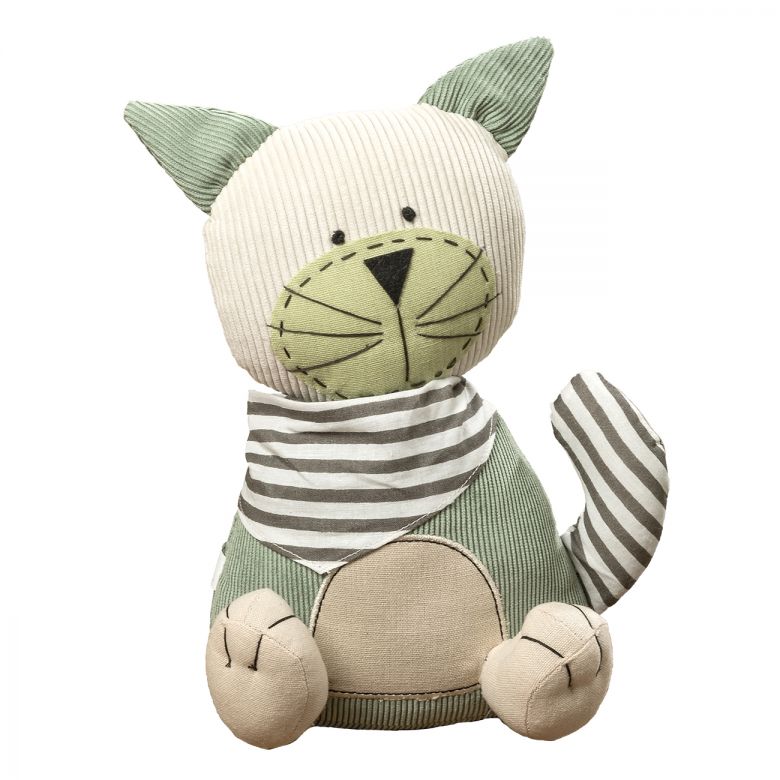
Open sesame:there are also many door-opening “experts” among cats! A skilful jump on the handle and the door opens: it is best to lock doors intended to be kept shut.
Washing machines and dryers
Cats love places that are toasty and sheltered to boot: washing machines and dryers that give off residual heat – with or without laundry – are therefore ideally suited to our kitties, as they can relax there undisturbed!
However, this can end in tragedy if a 60-degree wash is pending and the cat is inside the machine, It is better to take a quick look inside before each wash or drying cycle.
It is just like checking over your shoulder in road traffic: it is rather unlikely someone will be there, but in the worst case scenario that somebody is – or that a cat is in the drum – it is always better to be safe than sorry!
Look first, then switch it on! This cat check should become second nature to cat owners.
Plants
There are plants that are harmless to cats, but others should be removed from the cat household. Which ones exactly? Which are the “good” plants and which are poisonous to cats?
“Good” plants: heather, cockscomb, camellias, coconut palms, daisies, lemon trees and cypress. Poisonous plants: wisteria, ivy, ferns, gum trees, oleander and jasmine
Careful! Please make sure that watering cans with residual fertiliser or pesticides are always kept out of your cat’s reach!

At a glance:
Here you can download an overview of plants that are poisonous to cats, which you can refer to when shopping:
Table of plants poisonous to cats for download
You can refer to this list if you are unsure when buying plants.
How can I make my balcony safe for cats?
Yay! A spot in the sun! Cats also love balconies! There are many interesting sensations here: smells, sounds, prey – ahhh, birds – flying by, it would be a great place to spend an entire day.
However, the balcony should also be a safe place , which is a task for the cat lover. Before doing so, you should get permission from the owner if your flat is rented.
Nets for balconies come in different colours and mesh sizes, from small to very large (20–50 mm). Please opt for a smaller mesh size so that the cat cannot slip through. The material should be of high quality. Preferably UV resistant and most importantly tear and bite resistant. Your cat will greatly enjoy having a nice little climbing and resting corner, perhaps partially shaded; then you can both enjoy the balcony to the full.
Plastic bags
Always put plastic bags away immediately and store them so that cats can’t reach them! As cats like to explore everywhere and crawl inside everything (“something is rustling over there, something must be inside”), they can easily suffocate or ingest less-than-tasty parts. Even just the bag handles are risky since they are easy to get tangled in.
Aside from the fact that plastic bags are “rubbish” environmentally speaking, if you must have bags, choose paper ones! Cats love to play with them and they cannot injure themselves – even when a piece is bitten off, since it is a biodegradable item and is recycled (and disposed of) organically. You get where we are going with this… Then there is the carton: stable carton is preferable and can be well explored with a few extra openings. Simply cut a few big holes and place it on top of a blanket – cats can enjoy it for much longer there.
Bottom line
A reputable writer would underline the positive answer “Yes!” to the question “Do suitable homes for cats even exist?”. However, it is not so simple. A happy medium between home and free space is ideal, but this compromise often doesn’t exist.
Cats kept at home that have the right living conditions suitable for their species tend to live longer. But can a cat that is only familiar with a house really be happy during its long life?
This can only be judged by the person the cat is living with.
It’s in your hands – make something out of it!
